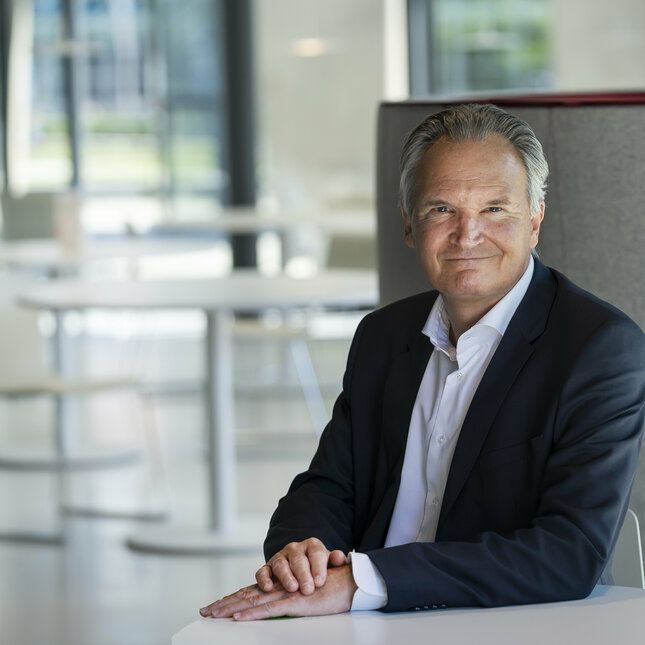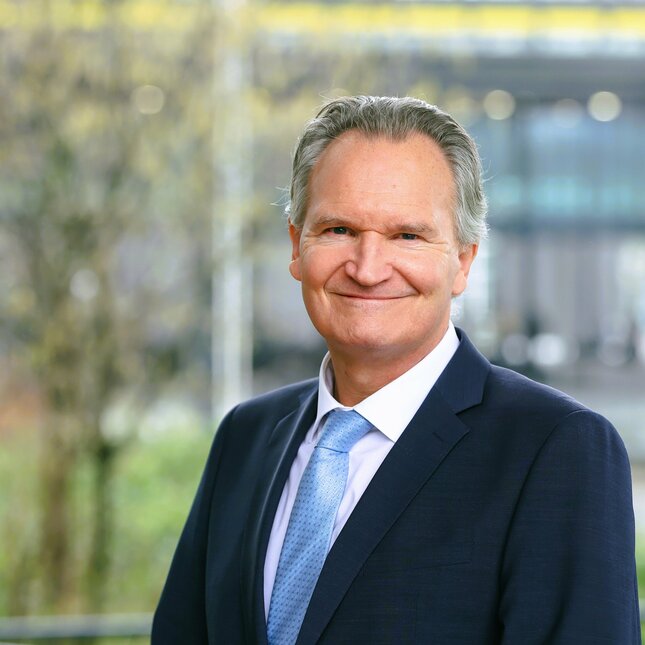
"Recently I spoke to an alumnus who had just become CEO of a company in the automotive industry. Having graduated from TU/e 20 years ago, he had not heard or seen much more of his alma mater. So, he really had no idea what we are all about here. We took him on a tour of our automotive lab. He was flabbergasted and very pleasantly surprised. He became really proud of his alma mater again and he saw several opportunities for collaborations with his company."
Networking works
With this anecdote, our conversation with Robert-Jan Smits, chairman of the TU/e Board of Governors and, among other things, board member of our university fund (UFE), begins. His account of the visit shows the power of networking, but also exposes a problem that has long plagued TU/e: the lack of meaningful contact with its alumni.
Robert-Jan acknowledges that problem and has an explanation for it: "TU/e is a scientific institute that trains engineers. It is therefore in our nature to look mainly to the future. But our common past can help us enormously to make even more progress in that future. If we stay in touch with our alumni, exchange knowledge with them, set up collaborations and ask them to become donors. I have heard anyone say they had a bad time at TU/e. Most call their studies here the best time of their lives and are only too happy to give something back. That is a wonderful basis for long-term and fruitful relationships, but of course you must maintain them.
On top of developments
Under the leadership of Edith Snelders and Ton Backx, the University Fund and the Alumni Relations Office are now fully engaged in strengthening ties with our alumni. And according to Robert Jan, they are doing a great job: "We soon saw the first results, for example during the Impact Nights. These are popular and well-attended events, organised by the University Fund. During these evenings, the fund's donors get unique insights into the projects they help make possible.
Robert Jan: "That's the kind of event I love to attend and where I always come home immensely proud. The scientists themselves come there to talk about what they have discovered partly thanks to the UFE, what they are doing and where it will lead to. As a visitor, you get to watch the first stages of research that are going to make our world healthier and more sustainable. Isn't that wonderful?”

Successful and equal collaboration
Robert Jan: "On those evenings, too, we often reacquaint ourselves with alumni. From that, quite often donations follow, or collaborations arise. That is why it’s a good thing that we now open the shutters to the outside world more than ever, share what is happening on Campus and actively invite our alumni. Their donations and the collaborations help us move forward. Just look at what we have already achieved in our history, together with our partners from industry in the region.”
Collaboration is in TU/e's DNA. Robert Jan, "That of course has a lot to do with our history. The people from Philips and DAF were welcome here and vice versa. We can really help those companies because we can think ‘out of the box’ very well. We look at developments differently and have a healthy disrespect for the status quo. Conversely, they help us move ideas forward and give new directions, as we see, for example, in our collaborations with the Catharina Hospital and the Maxima Medical Centre. Many companies in the region and beyond see our added value. We work with them as equal partners. We don't walk by their hand, but we walk together.”
ASML & Nokia
As an example, Robert-Jan cites the cooperation with ASML "They mainly ask us to think “out of the box” and certainly not to try what their hundreds of researchers can do much better: further develop their products. Our strength lies elsewhere: we can help them come up with completely new concepts. In this context, I always mention the example of Nokia, which did not see the revolutionary breakthrough of the iPhone coming. With our knowledge, experience and creativity, we help ASML, among others, to stay far ahead of such scenarios. The cooperation TU/e has with the big companies in Brainport therefore gives us the space to set up the most extraordinary and innovative projects.
Partnering with ASML makes sense for several reasons, according to Robert Jan. Not only because TU/e and ASML operate in the same region and because TU/e scores well on the competences and skills that companies like ASML need, but also because only a large majority of the students stay in the region after graduation. So indirectly, through cooperation with TU/e, they secure the influx of talent.
Funding fundamental research
During one of the Impact Nights, Robert-Jan stressed the importance of donating to the University Fund. Robert Jan: "Governments and committees that allocate research budgets often fail to see the great social importance of fundamental research, or cannot appreciate the creative ideas of young talent. We therefore focus mainly on those who do: the approximately 45,000 alumni in our database.
Robert-Jan is very happy with the results so far. At the same time, he also wonders why donating to universities and other institutions is much less common here than in the country where he himself studied: the United States: "If you are wealthy there, you give generously, for example to universities. That's the most common thing in the world. And this involves donations of a magnitude we don't see in the Netherlands. Of course, you cannot compare these two countries, but I would really welcome a similar social commitment to our scientific education here.
A look into the future
Looking ahead is of course partially guesswork, but Robert-Jan does have some ideal scenarios in mind for the University Fund and TU/e: "We have already started to support innovative projects as much and as quickly as possible. By doing so, we create perfect examples of what is possible and these in turn attract new donors. This is why we also have firm recruitment ambitions: we want to have raised around 30 million in 10 years' time.”
Robert-Jan concludes on a more personal note: “Of course it would be wonderful if one big donor would stand up and donate a huge amount to the Fund and/or TU/e, but I am enormously grateful for all the beautiful sums we have received in recent years and of course for the fact that many alumni have rediscovered our beautiful university."